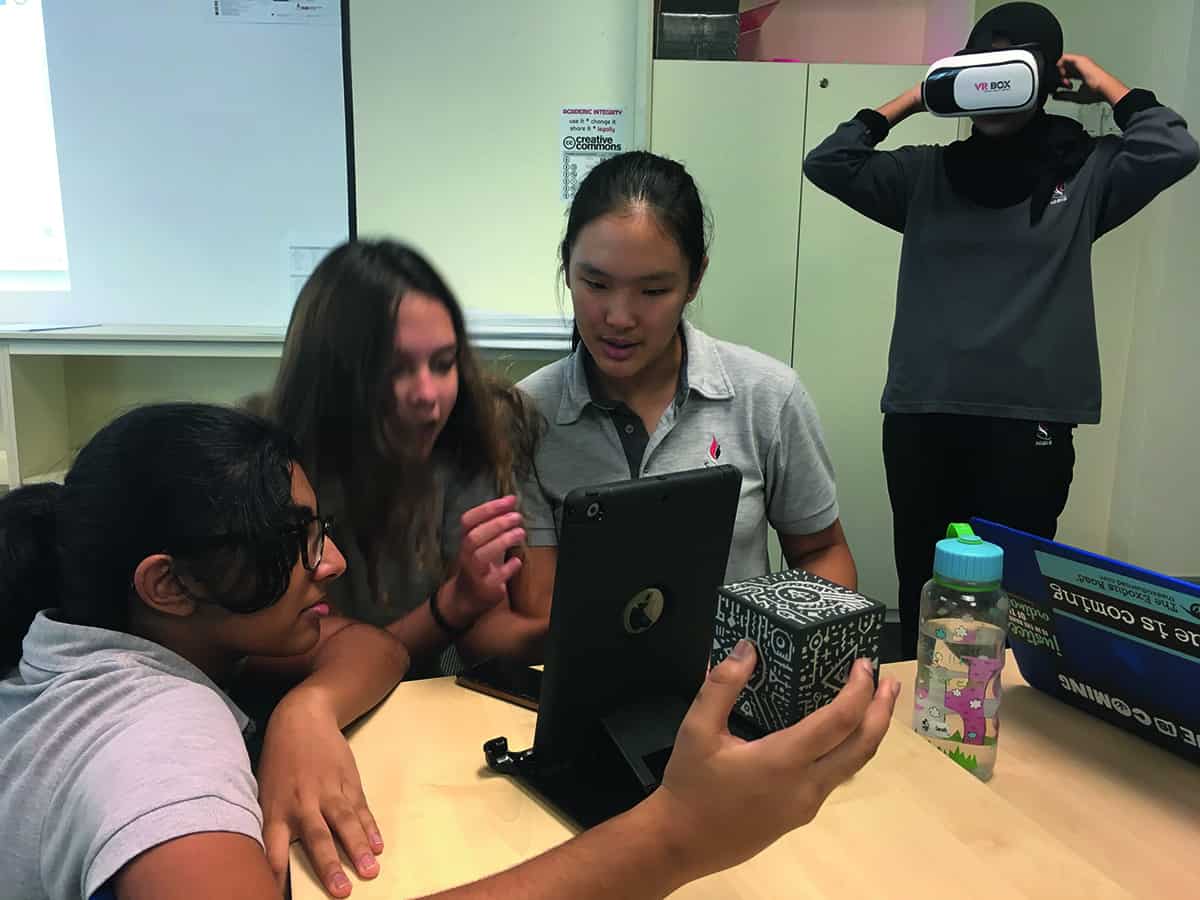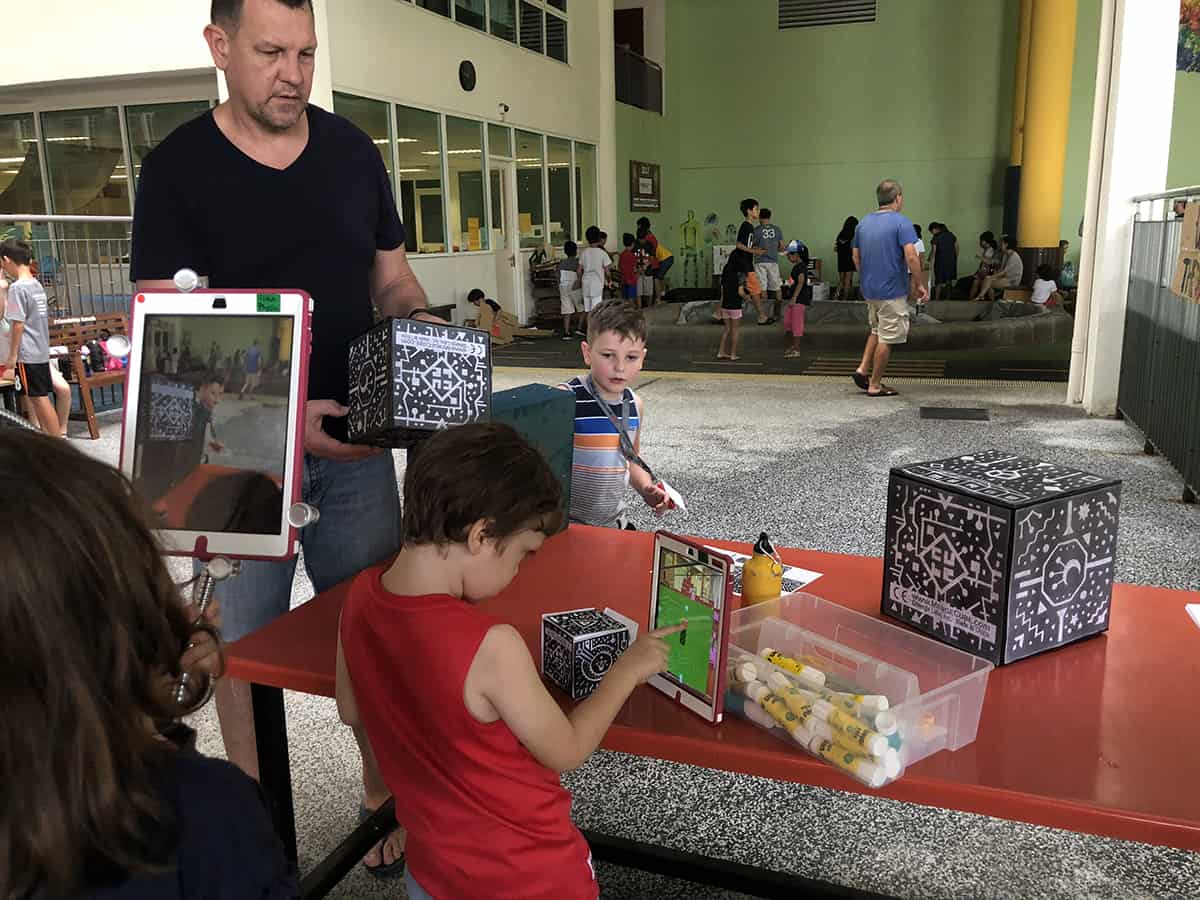In the first part of this series, we look at edtech innovations and how they can aid and extend learning

A Merge Cube allows students to turn a beating heart around in their hand
Technology is changing every aspect of our lives, and that includes education. The huge choice of educational technology (‘edtech’) now available—from apps and platforms to augmented reality (AR) and artificial intelligence (AI)—can be mind-boggling for teachers and schools.
But students need to be prepared for a world that is being transformed by a host of emerging technologies. And if used appropriately, edtech can enhance learning. According to the 2018 Bett Innovation Index—a survey of over 1,000 teachers in the UK and Europe—87% of teachers/school leaders believe technology has a positive impact on educational outcomes.
Pilar Quezzaire, Curriculum Manager for Educational Technology and Design at the IB, says: “Edtech serves schools that know their mission and pedagogy, and who strategize with technologies that aid and extend them both.”
Introducing technology successfully
As the technology gets more advanced, it’s only going to get harder for schools to decide what to use and how to get the most from it. Schools are faced with not only choosing the technology to adopt but also how to properly scope the cost (especially when free tools are not the answer).
Rose Luckin is Professor of Learner Centred Design at the UCL Knowledge Lab, in London, Director of EDUCATE, and a speaker at this month’s Bett show in the UK. She advises that schools should conduct a needs assessment. This will help identify technical tasks that need to be performed by the school, which are not currently being achieved. It also helps identify the needs of the school that should be achieved using technology.
“A needs assessment is more about the school’s objectives than it is about the technology itself,” she says. “This exercise should include all relevant members of school staff and should not be limited to the senior leadership team and/or technology lead at the school.” The EDUCATE project (which helps educational technology developers to better grasp learning processes and helps educators to better understand AI) has developed an online tool and support package to help schools complete an edtech needs assessment.
Proving the benefits of new technology by modelling or running trials is important, says Geoffrey Derry, Technology Integration Specialist at IGB International School, Malaysia. And so is supporting staff when introducing it.
Quezzaire says schools need to ask themselves in the first instance, “Why am I doing this?”. It is also vital that both teachers and students understand why the technology is being introduced, and can immediately see how it helps them or expands their knowledge.
Derry agrees: “To implement change it is very important to explain the ‘why’. Why do we want to use this new technology? Why do we want this change? If you can clearly articulate ‘why’, it is easier to get people on board and to get them to be part of the process of change.”
Amy Heusterberg-Richards and Vicki Quinn are two IB educators at Bay Port High School, Wisconsin, USA, who integrate technology tools into their English courses. Heusterberg-Richards says: “Technology offers extra avenues for students to generate ideas, both individually and collectively. Our classrooms consist of student voices sharing, questioning, and building upon these shared thoughts. Most days the technology on which students gather ideas is on computer screens as well as on the classroom whiteboard. Students are discussing with and adding to one another’s inquiries.”
But she cautions: “The technology tool itself sometimes can become the centre of student learning, overshadowing the subject skills. I believe tech is a means in my English class, but should not be the sole end. That balance is, at times, a hard one to find as educators.”
Quezzaire is seeing IB World Schools use technologies to enhance core tenets of the IB programmes such as multilingualism and IB learner profile development, as well as approaches to learning. “Schools are using tools to help students, but are also actively seeking learning management systems and teacher-based tools to record and analyse how teachers plan with—and students use—these core tenets,” says Quezzaire.

IGB International School students interact with virtual images
The rise of AI
A technology set to revolutionize teaching and assessment in the coming years is AI. The AI market in US education is expected to grow by 47.77% from 2018-2022, according to the Artificial Intelligence Market in the US Education Sector Report.
“Machine learning for memorization and revision of content is becoming common, primarily in the form of interactive textbooks and online assessment solutions,” says Quezzaire.
Professor Luckin says: “There are AI systems which provide personalized feedback and individualized activities to support learners and provide detailed information for teachers about their students’ performance. And there are systems that use AI to identify the most suitable resources to a teacher or student.”
Professor Luckin argues that using systems driven by AI to assist student learning will free up time for “teachers to focus on the all-important power skills and knowledge for the 21st century, such as collaborative problem-solving, accurately perceived self-efficacy and sophisticated epistemology (to help us know what knowledge is, what evidence is and how we can tell truth from fiction). In other words, AI can help us to become smarter humans”.
AI is not going to take away teachers’ jobs. Instead, Professor Luckin believes that AI can relieve teachers of some of the burdens of routine record keeping and marking, allowing them to spend more time with their students.
But she says it is crucial that teachers are educated about AI and understand why data is important, how AI processes data to reach decisions, what it can’t do, when to challenge it and when to worry about saying “yes” to terms and conditions when using some tech. “We need our AI developers to be working hand in hand with our educators to develop the best possible AI for education,” says Professor Luckin.
Tools to aid inclusivity
The development of natural language processing to enable voice-activated interfaces, currently seen in consumer products such as Google Home, Amazon’s Alexa and Apple’s Siri, offers huge potential in education. “To use the voice as a way of interacting with computer technology brings about many possibilities that can help engage people in learning,” says Professor Luckin. And it can be used to help create more inclusive learning experiences.
IGB International School uses accessibility tools that read text to students or allow them to voice type. “While these accessibility tools are often used for students who are struggling or have disabilities, we find that they are useful for all learners,” says Derry. The school has also been using Google Home in some of its younger classes as an extra helper and a way to introduce students to questioning skills and search techniques.
AR and VR experiences
IGB International School is one of many IB World Schools that have been exploring AR (augmented reality) and VR (virtual reality). VR is a computer-generated experience that lets students interact with a virtual world via a video headsetWhereas AR uses a phone or a tablet and augments or adds something to what the user sees through the screen.
“Using tools like Google Expeditions, Civilisations AR and Merge Cubes, our students have been able to virtually visit places all over the world and bring artefacts into their classroom,” says Derry. But now the school is getting students to create their own AR and VR experiences, for example making 360-degree videos using tools such as Panoform. “It gives them another avenue to demonstrate their understanding, to share their world view or to promote empathy,” says Derry.
“We believe that while consumption of these tools is valuable, creation is much more stimulating, engaging and involves higher-order thinking and problem-solving for our students.” (In part two of our series, we will explain how AR/VR can be used to aid inquiry.)

PYP students at IGB International School explore how Merge Cubes work
Enhancing student interaction
Game-based programs (gamification) are also popular classroom tools. Used widely for learning to code and design in digital environments, they can increase student interaction and offer opportunities to solve authentic problems in many subjects.
There are also numerous free tools available that can enhance cooperation and discussion. English teacher Quinn says: “I encourage my students to use Padlet to share ideas and research points.”
Heusterberg-Richards says: “I use Get Coffee often as a discussion question generator. It’s simple and effective. Students can propose questions which are quickly input into a website generator. It is a means to practise on-the-spot, effective responses needed for Diploma Programme (DP) English.”
“I’ve recently added FlipGrid to my IB English course, as it allows my students to collaborate internationally with peers who are not in the same time zones.” This video discussion platform allows educators to create a grid community for students to share their videos.
Heusterberg-Richards adds: “A favourite lesson of the year was using Google Quick, Draw! with my sophomores in an introductory class on literary analysis. They first played with the tool, then studied how the neural network made its guesses, and finally discussed how these same strategies could assist close readers while interpreting literature.”
Quinn does warn that “technology in the classroom can be problematic when previously free tools are now a cost or when the problem-solving for the tool takes more time than the learning and sharing of the content”.
This comes back to schools and teachers making sure they know why they want to use a particular technology and how it will aid learning. And at the same time, edtech companies need to work with schools to develop the most effective tools.
Visit the IB stand at Bett, 23-26 January, at ExCeL London, UK. Our team will be there to talk about eAssessment in the IB Middle Years Programme (MYP) which was awarded Best Use of Summative Assessment and was highly commended for Best Transformational Project at the eAssessment Awards in 2018. Bett is the world’s leading education technology event where educators can discover more than 800 innovative edtech suppliers and hear talks from industry experts.
See Amy Heusterberg-Richards and Vicki Quinn’s website I Be Learning, which has information on free technology tools.
